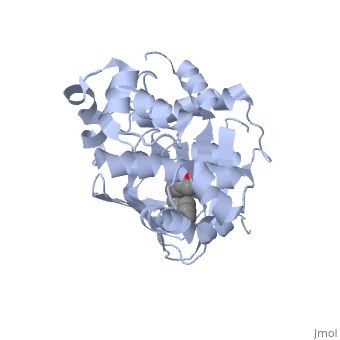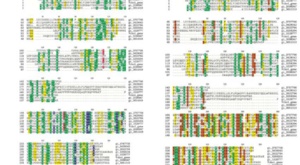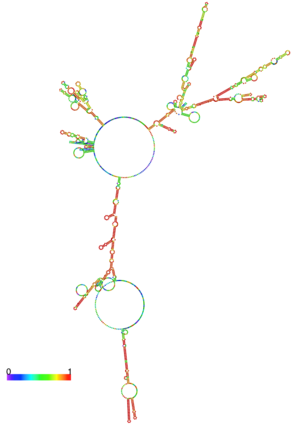ToxT
From Proteopedia
(Difference between revisions)
| Line 1: | Line 1: | ||
<StructureSection load='3gbg' color='structure' size='350' frame='true' side='right' caption='ToxT complex with palmitoleic acid, 1.9 Angstrom resolution crystal structure, [[3gbg]]' > | <StructureSection load='3gbg' color='structure' size='350' frame='true' side='right' caption='ToxT complex with palmitoleic acid, 1.9 Angstrom resolution crystal structure, [[3gbg]]' > | ||
| + | __TOC__ | ||
The crystal structure of ToxT is resolved in monomeric form, after isolation from <i>Vibrio cholerae</i> strain O395.<ref name="structure">PMID: 20133655</ref> | The crystal structure of ToxT is resolved in monomeric form, after isolation from <i>Vibrio cholerae</i> strain O395.<ref name="structure">PMID: 20133655</ref> | ||
| Line 16: | Line 17: | ||
==Ligand== | ==Ligand== | ||
In this resolved structure, <scene name='ToxT_Transcriptional_Regulator_in_Vibrio_cholerae/Pam/2'>cis-palmitoleate</scene>[http://www.ebi.ac.uk/thornton-srv/databases/cgi-bin/pdbsum/GetPage.pl?pdbcode=3gbg&template=ligands.html&l=1.1] is shown, which can be bound in the beta sheet barrel (as discussed above). This unsaturated fatty acid reduces virulence expression in <i>Vibrio cholerae</i>. | In this resolved structure, <scene name='ToxT_Transcriptional_Regulator_in_Vibrio_cholerae/Pam/2'>cis-palmitoleate</scene>[http://www.ebi.ac.uk/thornton-srv/databases/cgi-bin/pdbsum/GetPage.pl?pdbcode=3gbg&template=ligands.html&l=1.1] is shown, which can be bound in the beta sheet barrel (as discussed above). This unsaturated fatty acid reduces virulence expression in <i>Vibrio cholerae</i>. | ||
| - | + | ||
==Further Study== | ==Further Study== | ||
Conclusive results about what activates ToxT itself has not yet been found. The varying activity of ToxT dependent on the presence of <i>cis</i>-palmitoleate or other unsaturated fatty acids represents a detailed method of effective pathogenicity in humans, but may not be a reasonable target for drug treatment. By restricting transcription (and thus translation and protein production) of virulence genes until the bacterium is determined to be in a favorable location for infection, <i>Vibrio cholerae</i> avoids wasting energy producing virulence factors that will just be cleared by the intestine. This is a specific mechanism to ensure that the bacterium also injects CT and TCP where they will do the most damage, perpetuating the infection. <ref>Kenneth Todar [http://www.textbookofbacteriology.net/cholera.html] ''Vibrio cholerae'' and Asiatic Cholera, Todar's Online Textbook of Bacteriology. Date of access: 2011-11-28.</ref> Despite the lack of information about what activates ToxT itself, it is understood that the transcription of ctxA and tcpA by vibrio cholerae is sharply reduced in the presence of oleic, linoleic acid, and arachidonic acid, all of which are components of bile. Therefore, one may hypothesize that it may be possible to use the structure of a UFA or SFA to design a small molecule inhibitor of ToxT which may be used to treat or prevent cholera. | Conclusive results about what activates ToxT itself has not yet been found. The varying activity of ToxT dependent on the presence of <i>cis</i>-palmitoleate or other unsaturated fatty acids represents a detailed method of effective pathogenicity in humans, but may not be a reasonable target for drug treatment. By restricting transcription (and thus translation and protein production) of virulence genes until the bacterium is determined to be in a favorable location for infection, <i>Vibrio cholerae</i> avoids wasting energy producing virulence factors that will just be cleared by the intestine. This is a specific mechanism to ensure that the bacterium also injects CT and TCP where they will do the most damage, perpetuating the infection. <ref>Kenneth Todar [http://www.textbookofbacteriology.net/cholera.html] ''Vibrio cholerae'' and Asiatic Cholera, Todar's Online Textbook of Bacteriology. Date of access: 2011-11-28.</ref> Despite the lack of information about what activates ToxT itself, it is understood that the transcription of ctxA and tcpA by vibrio cholerae is sharply reduced in the presence of oleic, linoleic acid, and arachidonic acid, all of which are components of bile. Therefore, one may hypothesize that it may be possible to use the structure of a UFA or SFA to design a small molecule inhibitor of ToxT which may be used to treat or prevent cholera. | ||
| Line 52: | Line 53: | ||
Bailey, C; Camilla. Boedeker, C; Edgar. Johnson, A; Judith. Kaper, B; James. Karaolis, R; David. Reeves, R; Peter. (1997). “A Vibrio cholerae pathogenicity island associated with epidemic and pandemic strains.” March 17, 1998 vol. 95 no. 6 3134-3139 | Bailey, C; Camilla. Boedeker, C; Edgar. Johnson, A; Judith. Kaper, B; James. Karaolis, R; David. Reeves, R; Peter. (1997). “A Vibrio cholerae pathogenicity island associated with epidemic and pandemic strains.” March 17, 1998 vol. 95 no. 6 3134-3139 | ||
| + | </StructureSection> | ||
[[Category:Topic Page]] | [[Category:Topic Page]] | ||
Current revision
| |||||||||||
Proteopedia Page Contributors and Editors (what is this?)
Ingrid Youngworth, Yang Yang, Michal Harel, Alexander Berchansky, Jaime Prilusky



